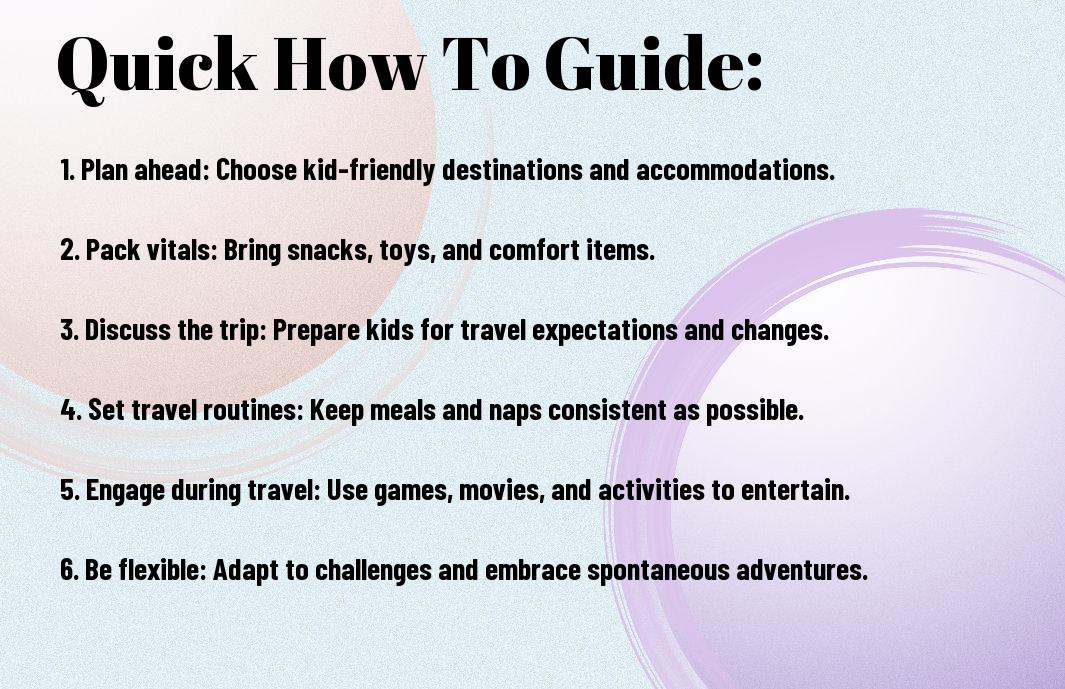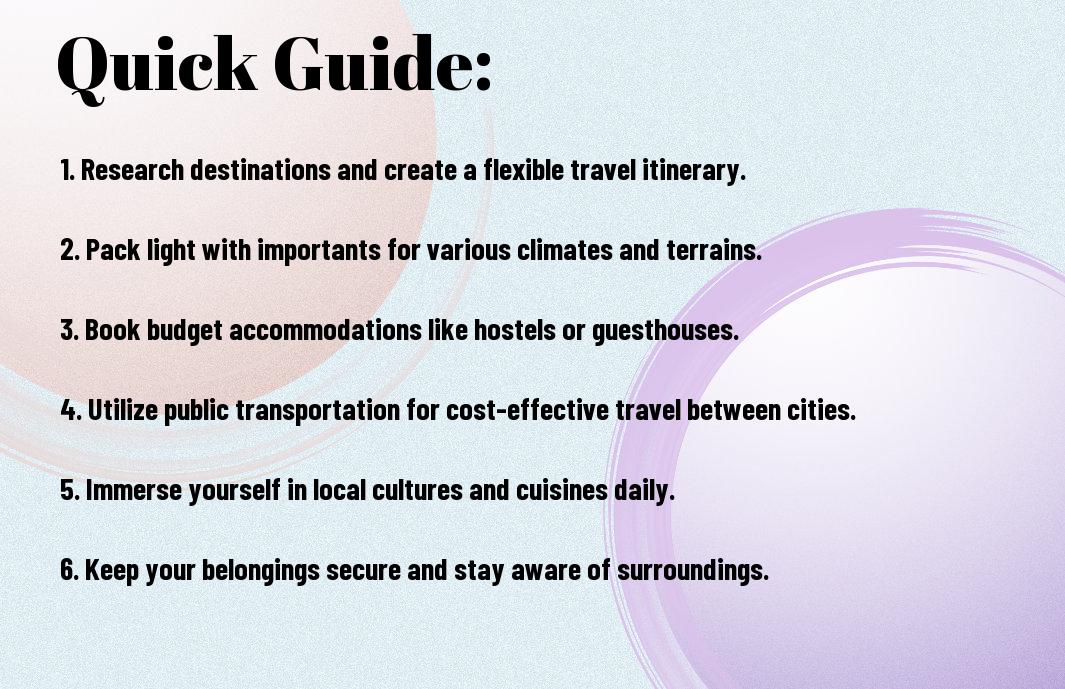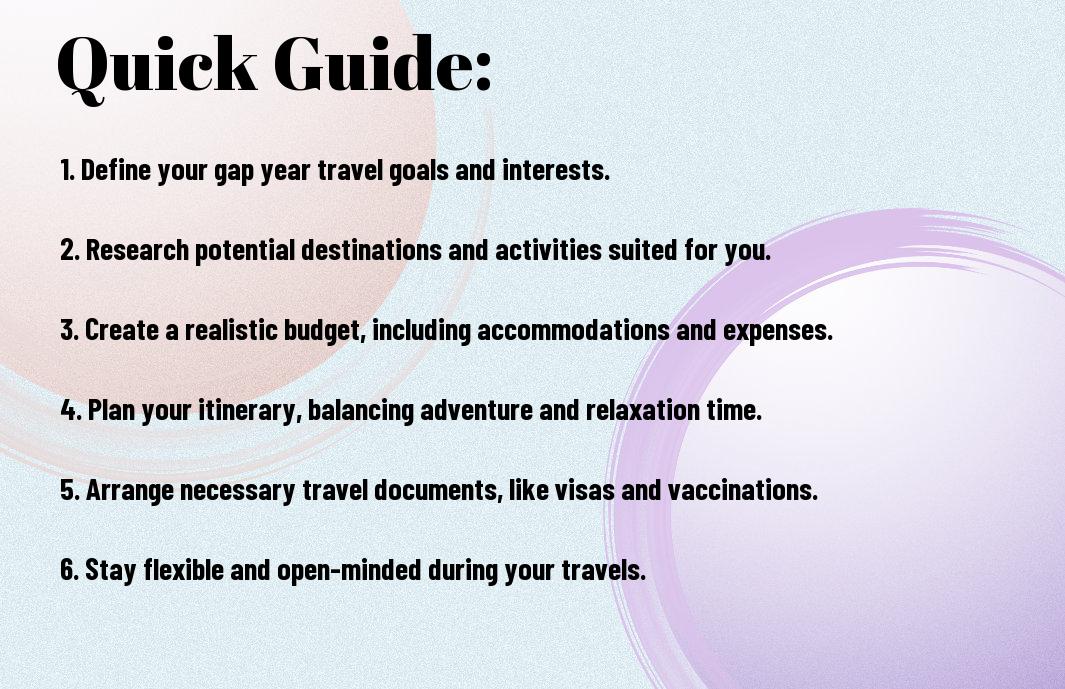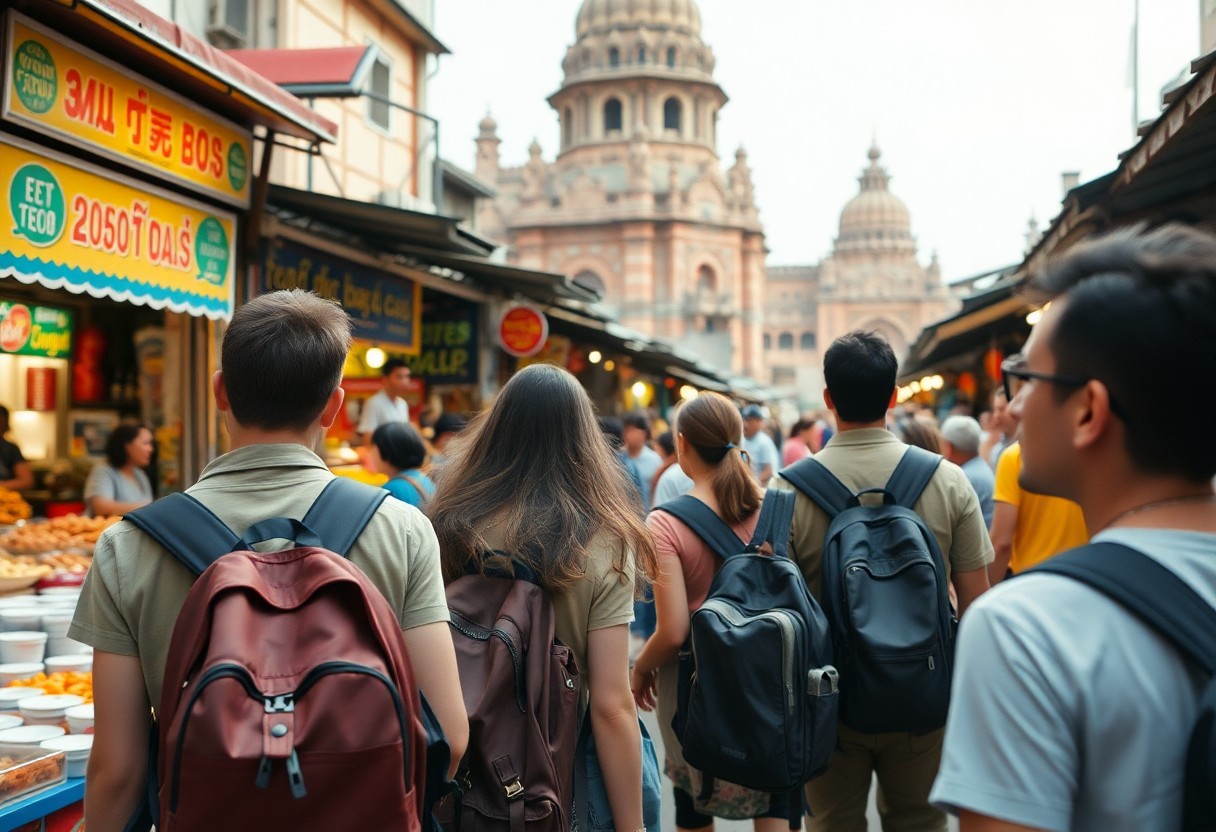Most travelers dream of exploring the world on their own terms, and solo travel can be a life-changing experience that offers both freedom and self-discovery. This guide is designed specifically for you to navigate the crucial aspects of traveling alone, from selecting your destination and planning your itinerary to ensuring your safety and making the most of your journey. With practical tips, resources, and personal insights, you’ll be empowered to commence on your solo adventure with confidence and excitement.
Key Takeaways:
- Research: Understand your destination’s culture, laws, and customs to enhance your travel experience and avoid misunderstandings.
- Safety: Prioritize your safety by staying aware of your surroundings, securing your belongings, and having emergency contacts handy.
- Planning: Create a flexible itinerary that allows for spontaneous adventures while ensuring you don’t miss out on key attractions.
- Socializing: Engage with locals and fellow travelers to enrich your experience and potentially form lasting connections.
- Budgeting: Keep track of your expenses and seek affordable accommodations and activities to make the most of your travel funds.
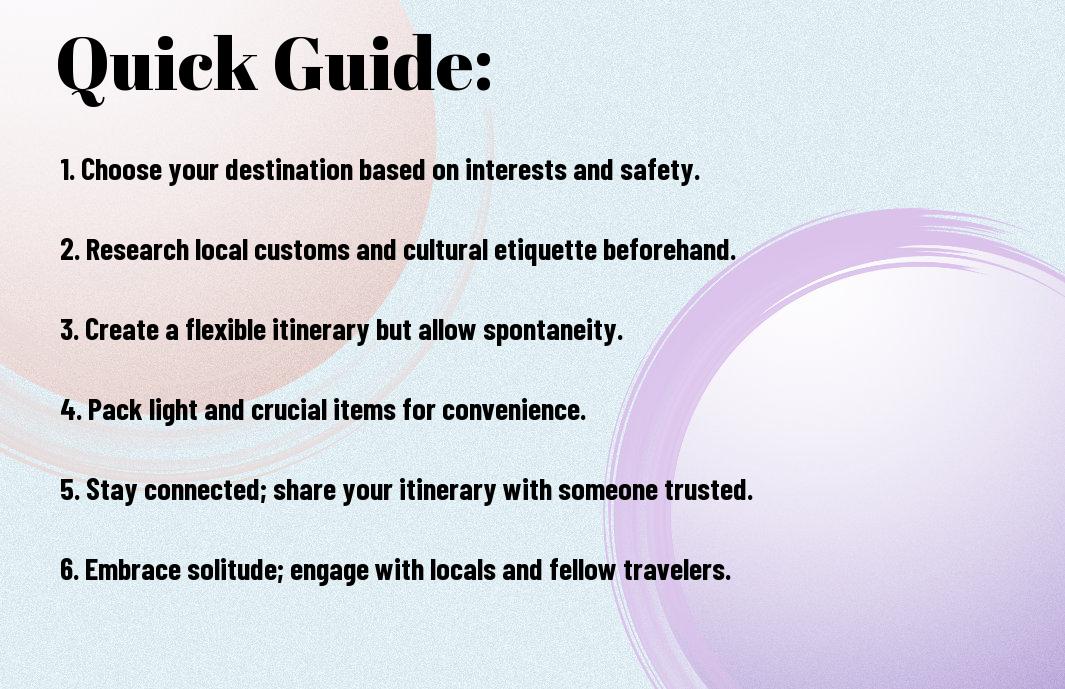

Types of Solo Travel
Before you commence on your solo journey, you should consider the different types of travel experiences that best resonate with you. Each type has unique benefits and challenges, making your choice impactful.
| Type | Description |
| Adventure Travel | Engaging in thrilling activities that challenge you physically and mentally. |
| Cultural Immersion | Deep entering into the customs, food, and traditions of a new culture. |
| Wellness Retreats | Focusing on your mental and physical well-being through various practices. |
| Volunteering | Giving back while exploring new places and meeting like-minded individuals. |
| Road Trips | Exploring new locations at your own pace and enjoying the open road. |
Recognizing what type of solo travel appeals to you will ensure a more fulfilling experience.
Adventure Travel
Assuming you crave adrenaline and excitement, adventure travel could be the perfect choice for your solo journey. This type often includes activities like hiking, rock climbing, or surfing, pushing you beyond your comfort zone.
Cultural Immersion
One of the most enriching forms of solo travel is cultural immersion, where you connect deeply with local customs and traditions. This experience allows you to engage directly with the culture, offering a unique perspective that traditional tours may not provide.
This could mean enjoying a cooking class in Italy, attending a local festival in Thailand, or volunteering with a community project. Such interactions foster genuine connections and create lasting memories, enabling you to see the world through a new lens.
Wellness Retreats
Adventure into wellness retreats, where you can rejuvenate your mind and body while exploring new destinations. These retreats offer venues for practices like yoga, meditation, and nutrition workshops, promoting a holistic approach to health.
Solo wellness retreats not only help you recharge but also provide an opportunity to reflect on your personal goals and aspirations. You can connect with facilitators and fellow attendees, fostering a sense of community even in your solitary journey.
Essential Tips for Solo Travelers
Assuming you’re commenceing on a solo adventure, it’s important to equip yourself with crucial tips to enhance your experience. Begin by embracing flexibility, managing your expectations, and staying open to new encounters. Here are some key points to consider:
- Stay connected with family and friends.
- Trust your instincts.
- Learn basic phrases in the local language.
- Keep your important documents secure.
- Blend in with locals to avoid drawing attention.
The journey is as much about the people you meet as it is about the sights you see.
Safety Precautions
Little adjustments in your mindset can greatly enhance your safety while traveling solo. Always stay alert in crowded areas, keep your valuables close, and share your itinerary with trusted contacts. Carry personal defense tools as allowed, and familiarize yourself with local emergency numbers to ensure help is readily available when needed.
Packing Wisely
Little habits, like packing light and choosing versatile clothing, can make your trip far more enjoyable. Prioritize items that serve multiple purposes and stick to a color palette for easy mixing and matching. Investing in travel-sized toiletries and a reliable daypack will also streamline your experience.
With a well-thought-out packing list, you can avoid the burden of excess baggage and focus on your travel experiences. Opt for lightweight, quick-dry fabrics and practical shoes to navigate various terrains effortlessly. Consider incorporating a portable charger or a universal adapter to keep your devices powered on the go. Bringing the right gear will help you travel smarter.
Budgeting for Your Trip
Safety in managing your finances can significantly impact your travel experience. Set a realistic budget that includes accommodations, meals, activities, and transportation. Keep track of your daily expenses to avoid overspending and find opportunities for saving during your trip.
Precautions in budgeting extend to ensuring you have access to funds without relying solely on your credit card. Use a combination of cash and cards while keeping backup options like a prepaid travel card. Research local prices beforehand to understand the cost of living and what you can afford, enabling you to allocate your money wisely while exploring each destination.
Step-by-Step Planning for Your Solo Journey
To initiate on your solo adventure, you need a clear, actionable plan that covers all aspects of the trip. Below is a structured guide to help you navigate this process effectively.
| Planning Steps | Details |
|---|---|
| Researching Destinations | Choose a destination that aligns with your interests and safety preferences. |
| Booking Accommodations | Secure a place to stay that is safe, comfortable, and convenient. |
| Creating an Itinerary | Outline your daily activities, including sights to see and experiences to enjoy. |
Researching Destinations
Journeying into the world of solo travel starts with selecting the right destination. Prioritize locations that not only pique your interest but also offer a welcoming atmosphere for solo travelers, such as vibrant cultures, safe environments, and plenty of social opportunities.
Booking Accommodations
If you’re eager to secure your perfect refuge, choosing the right accommodation is key. Look for hostels, hotels, or vacation rentals that fit your budget and style, while also considering safety, location, and amenities that enhance your solo experience.
Another great tip for booking accommodations is to read reviews from fellow travelers. Websites like TripAdvisor and Airbnb often provide valuable insights that help you gauge whether a property meets your needs and expectations. Moreover, connecting with local hosts can offer unique local experiences, making your stay even more memorable.
Creating an Itinerary
With your destination chosen and accommodations booked, it’s time to outline your adventure. Creating an itinerary allows you to manage your time effectively, ensuring you don’t miss out on any must-see attractions while also leaving room for spontaneous experiences.
Your itinerary should strike a balance between structure and flexibility. Consider dividing your days into manageable chunks that highlight key activities, including cultural landmarks, dining spots, and leisurely moments. This approach will empower you to fully immerse yourself in the local culture while allowing for adjustments and new discoveries along the way.
Factors to Consider Before Traveling Alone
All solo travelers should assess several important factors before taking the plunge. Consider these key aspects:
- Your safety and well-being
- Travel restrictions and documentation
- Local customs and laws
- Health and insurance considerations
Knowing these elements will greatly enhance your solo travel experience. For a comprehensive overview, consult our Solo Travel Guide.
Travel Restrictions
With the dynamic landscape of global travel, understanding current travel restrictions is imperative. Research the entry requirements, visa needs, and health regulations like vaccinations or quarantine rules in your destination country.
Local Customs and Laws
Alone in a new country, you must be aware of and respect local customs and laws. Familiarizing yourself with cultural norms will not only enrich your experience but also keep you out of potential trouble.
For instance, dress codes, public behavior, and tipping practices can vary significantly across cultures. It is beneficial to engage with local customs to show respect and enhance your interactions with residents.
Health and Insurance Considerations
You should prioritize your health and safety while traveling solo. Ensure you have comprehensive travel insurance, and review your health care options and any necessary vaccinations for your destination.
A solid insurance policy can cover unexpected medical expenses, trip cancellations, or lost belongings, providing you peace of mind as you explore new places. Always consider health risks specific to your travel location, from common illnesses to access to medical facilities.
Pros and Cons of Solo Travel
After considering solo travel, it’s vital to weigh its advantages and disadvantages. The experience can be both rewarding and challenging, and understanding both sides helps you make an informed decision. Below is a breakdown of the pros and cons you might encounter on your journey.
| Pros | Cons |
|---|---|
| Complete freedom to create your itinerary | Feelings of loneliness at times |
| Opportunity for self-discovery and growth | Higher costs with no one to share expenses |
| Ability to meet new people | Safety concerns and risks |
| Flexible travel pace | No one to turn to for support |
| Experience independence | Decision fatigue without a companion |
Advantages of Going Solo
On begining on a solo journey, you open yourself up to a world of adventure tailored entirely to your preferences. You can explore at your own pace, indulge in personal interests, and form genuine connections with locals or fellow travelers. The autonomy allows you to challenge yourself, leading to personal growth and empowerment that can significantly enhance your travel experience.
Challenges of Traveling Alone
With solo travel comes unique challenges that can test your resilience. You may encounter moments of isolation, confront safety concerns, and face logistical hurdles like navigating unfamiliar environments alone. It’s vital to be prepared for these potential obstacles to ensure your trip remains enjoyable and memorable.
Plus, you might find that lacking familiar company can lead to occasional feelings of insecurity. You could face language barriers, cultural misunderstandings, or simply the absence of someone to share your experiences with. Balancing your emotions while navigating through these challenges can significantly impact your journey. Keeping an open mind and being adaptable can make your solo adventure more fulfilling despite the hurdles you may face.
Connecting with Others While Traveling Solo
Now that you’ve taken the plunge into solo travel, connecting with others can enhance your experience and provide a sense of belonging. Embrace the opportunity to meet new faces, share stories, and create unforgettable memories. Engaging with fellow travelers and locals will enrich your journey, helping you to see the destination through different perspectives. Don’t shy away; step out of your comfort zone and explore the connections waiting to be made.
Meeting Locals
If you want to immerse yourself in the culture of a new place, meeting locals is a fantastic way to do so. Locals can offer insider tips, hidden gems, and authentic experiences that you won’t find in any guidebook. Approach conversations with openness and curiosity, and you might even form lasting friendships along the way.
Joining Group Activities
There’s no better way to connect with like-minded people than by joining group activities during your travels. Whether it’s a guided tour, a cooking class, or a hiking expedition, these experiences provide both adventure and camaraderie. You’ll already have something in common with other participants: a shared interest in discovering new things.
A group activity also fosters an environment where you can bond over shared experiences, making it easier to strike up conversations and form connections. You’ll find that many fellow travelers are eager to share their stories, tips, and laughter. Besides building friendships, these activities often lead to insightful cultural exchanges, allowing you to deepen your understanding of the destination while enjoying the company of others.
Conclusion
As a reminder, commenceing on a solo travel adventure abroad can be one of the most rewarding experiences of your life. By planning ahead and applying the insights outlined in this guide, you empower yourself to embrace new cultures, meet fascinating individuals, and discover the world at your own pace. Trust your instincts, stay open to new experiences, and allow your journey to shape the person you are becoming. Safe travels!
Q: What are the top tips for safe solo travel abroad?
A: Safety is a top priority when traveling alone. Here are some vital tips to ensure a secure trip:
1. Research your destination thoroughly before you go, including local customs, laws, and areas to avoid.
2. Share your travel itinerary with someone you trust, and stay in communication regularly.
3. Keep your belongings secure; use anti-theft bags and be mindful of your surroundings.
4. Trust your instincts; if a situation doesn’t feel right, seek help or remove yourself from it.
5. Consider purchasing travel insurance to cover unforeseen events, and have a backup plan for emergencies.
Q: How can I make the most of my solo travel experience?
A: Traveling alone can be an enriching experience. Here are some ways to maximize your journey:
1. Engage with locals; try to learn a few key phrases in the native language to facilitate conversation.
2. Be open to new experiences; take part in local activities, classes, or tours that pique your interest.
3. Journal your experiences daily to reflect on your journey and the lessons learned along the way.
4. Join group tours or meet-ups tailored for solo travelers to connect with others and share experiences.
5. Embrace spontaneity; allow time in your itinerary for unplanned adventures and exploration.
Q: What should I pack for solo travel abroad?
A: Packing wisely is important for a successful trip. Consider the following items:
1. A versatile wardrobe; choose clothing that can be layered and mixed and matched for various occasions.
2. Travel-sized toiletries and a basic first-aid kit to handle minor health issues on the go.
3. Essential electronics such as a power bank, universal adapter, and smartphone loaded with helpful travel apps.
4. A printed copy of important documents like your passport, travel insurance, and emergency contacts.
5. A lightweight, secure daypack for outings to carry importants while allowing for hands-free exploration.

